Mikhail Salnikov
Geopolitical biases in LLMs: what are the "good" and the "bad" countries according to contemporary language models
Jun 07, 2025Abstract:This paper evaluates geopolitical biases in LLMs with respect to various countries though an analysis of their interpretation of historical events with conflicting national perspectives (USA, UK, USSR, and China). We introduce a novel dataset with neutral event descriptions and contrasting viewpoints from different countries. Our findings show significant geopolitical biases, with models favoring specific national narratives. Additionally, simple debiasing prompts had a limited effect in reducing these biases. Experiments with manipulated participant labels reveal models' sensitivity to attribution, sometimes amplifying biases or recognizing inconsistencies, especially with swapped labels. This work highlights national narrative biases in LLMs, challenges the effectiveness of simple debiasing methods, and offers a framework and dataset for future geopolitical bias research.
Will It Still Be True Tomorrow? Multilingual Evergreen Question Classification to Improve Trustworthy QA
May 27, 2025Abstract:Large Language Models (LLMs) often hallucinate in question answering (QA) tasks. A key yet underexplored factor contributing to this is the temporality of questions -- whether they are evergreen (answers remain stable over time) or mutable (answers change). In this work, we introduce EverGreenQA, the first multilingual QA dataset with evergreen labels, supporting both evaluation and training. Using EverGreenQA, we benchmark 12 modern LLMs to assess whether they encode question temporality explicitly (via verbalized judgments) or implicitly (via uncertainty signals). We also train EG-E5, a lightweight multilingual classifier that achieves SoTA performance on this task. Finally, we demonstrate the practical utility of evergreen classification across three applications: improving self-knowledge estimation, filtering QA datasets, and explaining GPT-4o retrieval behavior.
LLM-Independent Adaptive RAG: Let the Question Speak for Itself
May 07, 2025Abstract:Large Language Models~(LLMs) are prone to hallucinations, and Retrieval-Augmented Generation (RAG) helps mitigate this, but at a high computational cost while risking misinformation. Adaptive retrieval aims to retrieve only when necessary, but existing approaches rely on LLM-based uncertainty estimation, which remain inefficient and impractical. In this study, we introduce lightweight LLM-independent adaptive retrieval methods based on external information. We investigated 27 features, organized into 7 groups, and their hybrid combinations. We evaluated these methods on 6 QA datasets, assessing the QA performance and efficiency. The results show that our approach matches the performance of complex LLM-based methods while achieving significant efficiency gains, demonstrating the potential of external information for adaptive retrieval.
How Much Knowledge Can You Pack into a LoRA Adapter without Harming LLM?
Feb 20, 2025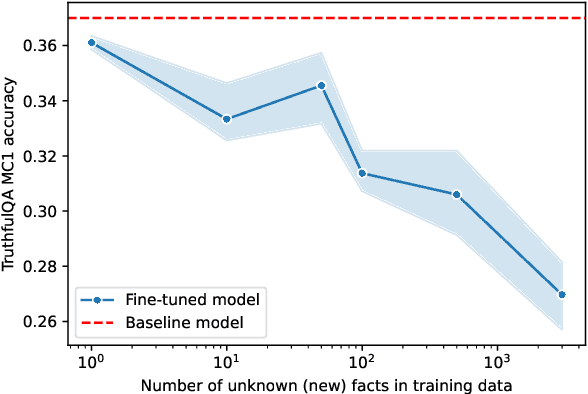

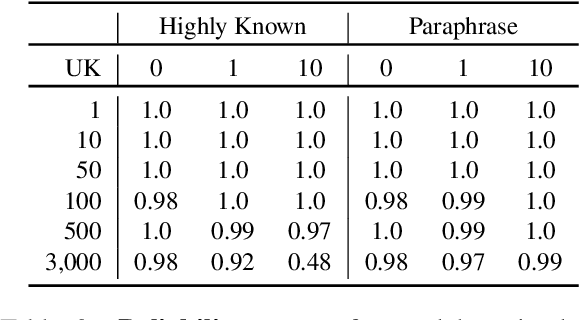

Abstract:The performance of Large Language Models (LLMs) on many tasks is greatly limited by the knowledge learned during pre-training and stored in the model's parameters. Low-rank adaptation (LoRA) is a popular and efficient training technique for updating or domain-specific adaptation of LLMs. In this study, we investigate how new facts can be incorporated into the LLM using LoRA without compromising the previously learned knowledge. We fine-tuned Llama-3.1-8B-instruct using LoRA with varying amounts of new knowledge. Our experiments have shown that the best results are obtained when the training data contains a mixture of known and new facts. However, this approach is still potentially harmful because the model's performance on external question-answering benchmarks declines after such fine-tuning. When the training data is biased towards certain entities, the model tends to regress to few overrepresented answers. In addition, we found that the model becomes more confident and refuses to provide an answer in only few cases. These findings highlight the potential pitfalls of LoRA-based LLM updates and underscore the importance of training data composition and tuning parameters to balance new knowledge integration and general model capabilities.
Konstruktor: A Strong Baseline for Simple Knowledge Graph Question Answering
Sep 24, 2024Abstract:While being one of the most popular question types, simple questions such as "Who is the author of Cinderella?", are still not completely solved. Surprisingly, even the most powerful modern Large Language Models are prone to errors when dealing with such questions, especially when dealing with rare entities. At the same time, as an answer may be one hop away from the question entity, one can try to develop a method that uses structured knowledge graphs (KGs) to answer such questions. In this paper, we introduce Konstruktor - an efficient and robust approach that breaks down the problem into three steps: (i) entity extraction and entity linking, (ii) relation prediction, and (iii) querying the knowledge graph. Our approach integrates language models and knowledge graphs, exploiting the power of the former and the interpretability of the latter. We experiment with two named entity recognition and entity linking methods and several relation detection techniques. We show that for relation detection, the most challenging step of the workflow, a combination of relation classification/generation and ranking outperforms other methods. We report Konstruktor's strong results on four datasets.
* 18 pages, 2 figures, 7 tables
Answer Candidate Type Selection: Text-to-Text Language Model for Closed Book Question Answering Meets Knowledge Graphs
Oct 10, 2023Abstract:Pre-trained Text-to-Text Language Models (LMs), such as T5 or BART yield promising results in the Knowledge Graph Question Answering (KGQA) task. However, the capacity of the models is limited and the quality decreases for questions with less popular entities. In this paper, we present a novel approach which works on top of the pre-trained Text-to-Text QA system to address this issue. Our simple yet effective method performs filtering and re-ranking of generated candidates based on their types derived from Wikidata "instance_of" property.
Large Language Models Meet Knowledge Graphs to Answer Factoid Questions
Oct 03, 2023Abstract:Recently, it has been shown that the incorporation of structured knowledge into Large Language Models significantly improves the results for a variety of NLP tasks. In this paper, we propose a method for exploring pre-trained Text-to-Text Language Models enriched with additional information from Knowledge Graphs for answering factoid questions. More specifically, we propose an algorithm for subgraphs extraction from a Knowledge Graph based on question entities and answer candidates. Then, we procure easily interpreted information with Transformer-based models through the linearization of the extracted subgraphs. Final re-ranking of the answer candidates with the extracted information boosts Hits@1 scores of the pre-trained text-to-text language models by 4-6%.
MMDF: Mobile Microscopy Deep Framework
Jul 27, 2020

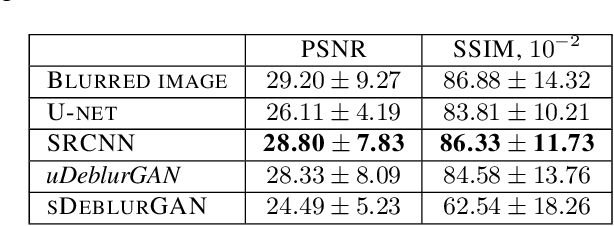
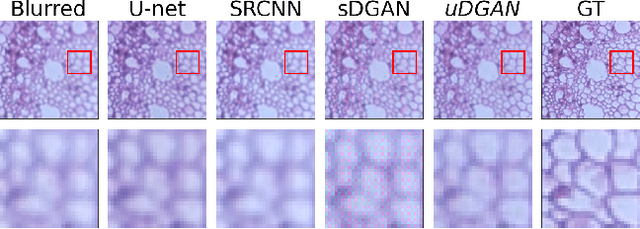
Abstract:In the last decade, a huge step was done in the field of mobile microscopes development as well as in the field of mobile microscopy application to real-life disease diagnostics and a lot of other important areas (air/water quality pollution, education, agriculture). In current study we applied image processing techniques from Deep Learning (in-focus/out-of-focus classification, image deblurring and denoising, multi-focus image fusion) to the data obtained from the mobile microscope. Overview of significant works for every task is presented, the most suitable approaches were highlighted. Chosen approaches were implemented as well as their performance were compared with classical computer vision techniques.
Multi-fidelity Neural Architecture Search with Knowledge Distillation
Jun 15, 2020


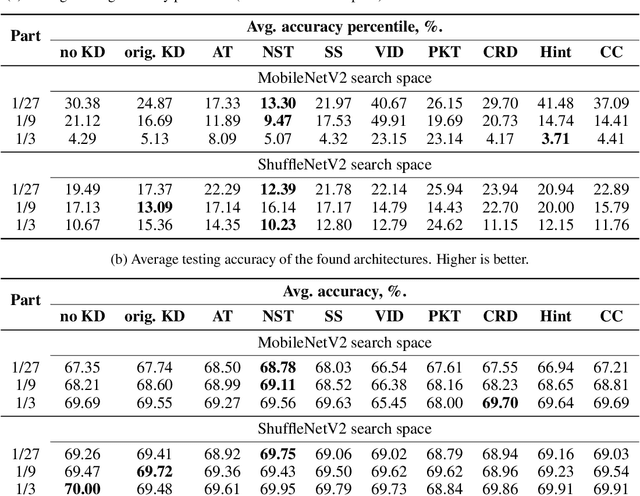
Abstract:Neural architecture search (NAS) targets at finding the optimal architecture of a neural network for a problem or a family of problems. Evaluations of neural architectures are very time-consuming. One of the possible ways to mitigate this issue is to use low-fidelity evaluations, namely training on a part of a dataset, fewer epochs, with fewer channels, etc. In this paper, we propose to improve low-fidelity evaluations of neural architectures by using a knowledge distillation. Knowledge distillation adds to a loss function a term forcing a network to mimic some teacher network. We carry out experiments on CIFAR-100 and ImageNet and study various knowledge distillation methods. We show that training on the small part of a dataset with such a modified loss function leads to a better selection of neural architectures than training with a logistic loss. The proposed low-fidelity evaluations were incorporated into a multi-fidelity search algorithm that outperformed the search based on high-fidelity evaluations only (training on a full dataset).
NAS-Bench-NLP: Neural Architecture Search Benchmark for Natural Language Processing
Jun 12, 2020



Abstract:Neural Architecture Search (NAS) is a promising and rapidly evolving research area. Training a large number of neural networks requires an exceptional amount of computational power, which makes NAS unreachable for those researchers who have limited or no access to high-performance clusters and supercomputers. A few benchmarks with precomputed neural architectures performances have been recently introduced to overcome this problem and ensure more reproducible experiments. However, these benchmarks are only for the computer vision domain and, thus, are built from the image datasets and convolution-derived architectures. In this work, we step outside the computer vision domain by leveraging the language modeling task, which is the core of natural language processing (NLP). Our main contribution is as follows: we have provided search space of recurrent neural networks on the text datasets and trained 14k architectures within it; we have conducted both intrinsic and extrinsic evaluation of the trained models using datasets for semantic relatedness and language understanding evaluation; finally, we have tested several NAS algorithms to demonstrate how the precomputed results can be utilized. We believe that our results have high potential of usage for both NAS and NLP communities.
 Add to Chrome
Add to Chrome Add to Firefox
Add to Firefox Add to Edge
Add to Edge